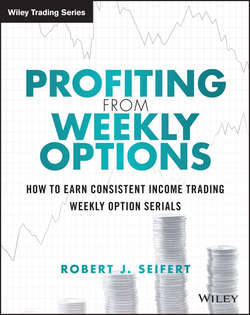Читать книгу Profiting from Weekly Options - Seifert Robert J. - Страница 6
На сайте Литреса книга снята с продажи.
Preface
ОглавлениеFor many years, it was difficult for individual option traders to compete with the banks and professional market makers in the derivative market. The bid–offer spreads were too big, the premium levels were so high that a retail trader could not afford to be involved, and finally, if their trade of choice was spreading, they had to wait months for the trade to mature.
Four years ago, weekly options didn't exist, and now they represent more than 30 percent of all options traded. There must be a reason for the phenomenal growth in such a short period of time. There is a reason, and it is very simple: Weekly options offer the best opportunity for any retail trader to get involved in the derivative market. This book is designed to reach any level of option trader, from the novice to successful traders that have yet to learn the power of weekly options.
The book is organized into sections, and after each part there is a quiz that reviews the key points that are emphasized in the chapter. The first section deals with market psychology and is designed to help you learn “the other side of the trade.” If you think you can just pick up a book and magically defeat your opponent without understanding the psychology of the market, then you must also believe that if you can hit a golf ball you could beat Tiger Woods. In both cases, you are only fooling yourself.
The second section teaches you that underlying asset groups have different characteristics, and it is important to learn how each type of asset can be traded. It will show you that some markets are ideal for trading and other markets are simply impossible to beat. Once you learn what markets can be played, you need to see how they look when you study them, the patterns that constantly repeat, and how to spot those patterns. In addition, you must be able to communicate to the broker or to your software execution platform the trades that you want to make. Options have a distinct vocabulary and you must learn certain terms in order to participate in the market.
The third section is devoted to the option model, how it is unique in the world of finance, and why you must familiarize yourself with how it is priced in order to succeed. Simple mathematical examples are given to help you adjust your vision of markets to the viewpoint of an option trader. The option chain is introduced and how comprehension of this vehicle will be all-important to your trading success.
The second-to-last section deals with four simple trades that you can continuously make. It explains when and how the trades should be initiated, what market conditions give you the best chance for the individual trade to succeed, and how to manage the trade once it is in place.
The final section demonstrates how to manage your greatest asset – cash. It clarifies how to utilize your capital in a manner that will ensure that you don't run the risk of ruin when the inevitable capital drawdown occurs, and it identifies which trades can be employed using your available capital levels.
After the final chapter, there is a final exam made up primarily of questions that you have been asked before. If you can score 90 percent or better, you should be ready to tackle the big players in the option market!
